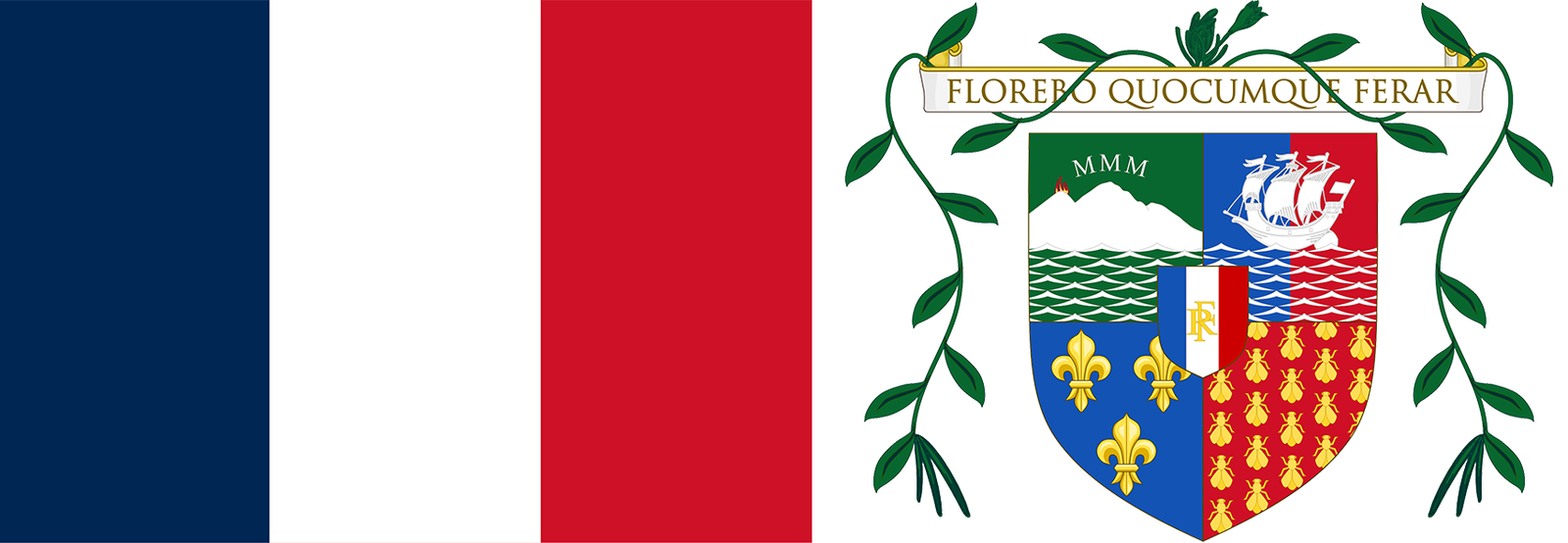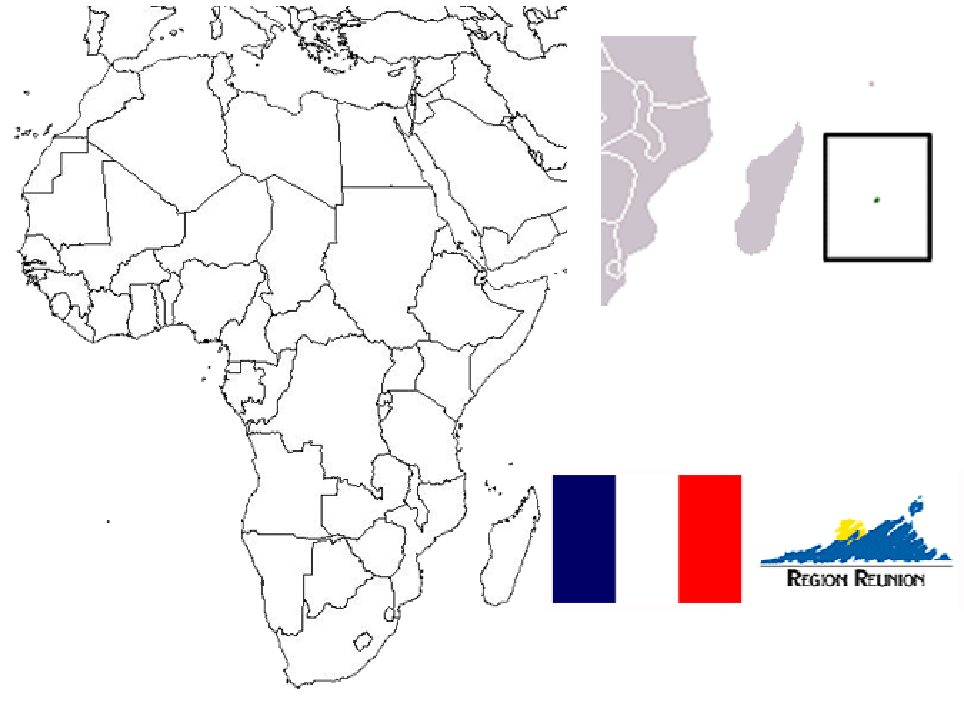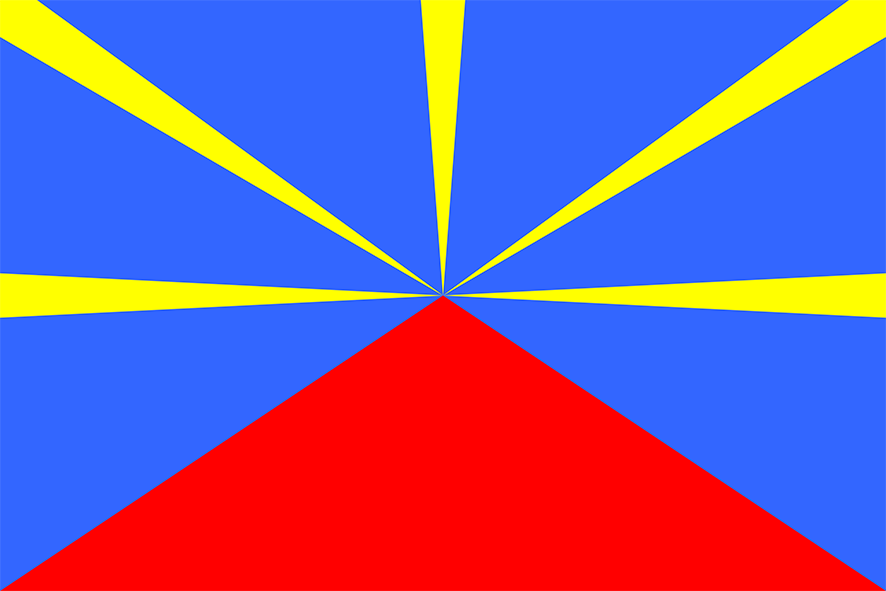FabulousFusionFood's Réunionese (from Réunion) Recipes Home Page
 The flag of Réunion (left) and the coat of arms of Réunion (right).
The flag of Réunion (left) and the coat of arms of Réunion (right).
Welcome to the summary page for FabulousFusionFood's Réunion recipes, part of East Africa. This page provides links to all the Réunionese recipes presented on this site, with 29 recipes in total.
This is a continuation of an entire series of pages that will, I hope, allow my visitors to better navigate this site. As well as displaying recipes by name, country and region of origin I am now planning a whole series of pages where recipes can be located by meal type and main ingredient. This page gives a listing of all the Indian recipes added to this site.
Being an island in the Indian ocean, Malagasy cuisine is derived from many sources and traditions. Curries, derived from India, are an important aspect of the cuisine. There is also an extensive Malay influence and thus foods containing pork and lamb are an important part of the diet. African stews are also common, though they are often flavoured with curry powder. Seafood also presents an important aspect of the diet and fish dishes served with rice are common.
These recipes, for the major part, originate in Réunion. Otherwise they are fusion recipes with major Réunionese influences.
Réunion, officially La Réunion (French) (La Rényon in Réunion Creole French) is an island in the Indian Ocean that is an overseas department and region of France. Part of the Mascarene Islands, it is located approximately 679 km (422 mi) east of the island of Madagascar and 175 km (109 mi) southwest of the island of Mauritius. As of January 2024, it had a population of 885,700. Its capital and largest city is Saint-Denis.
 The image above shows Réunion in relation to Africa (left) and Madagascar
The image above shows Réunion in relation to Africa (left) and Madagascar
(right) the flag and arms of Réunion are shown, inset.La Réunion was uninhabited until French immigrants and colonial subjects settled the island in the 17th century. Its tropical climate led to the development of a plantation economy focused primarily on sugar; slaves from East Africa were imported as fieldworkers, followed by Malays, Vietnamese, Chinese, and Indians as indentured labourers. Today, the greatest proportion of the population is of mixed descent, while the predominant language is Réunion Creole, though French remains the sole official language.
Since 1946, Réunion has been governed as a French region and thus has a similar status to its counterparts in Metropolitan France. Consequently, it is one of the outermost regions of the European Union and part of the eurozone;[3] it is, along with the French overseas department of Mayotte, one of the two eurozone areas in the Southern Hemisphere. Owing to its strategic location, France maintains a large military presence.
Etymology: France took possession of the island in the 17th century, naming it Bourbon, after the dynasty that then ruled France. To break with this name, which was too attached to the Ancien Régime, the National Convention decided on 23 March 1793 to rename the territory Réunion Island. ('La Réunion', in French, usually means 'meeting' or 'assembly' rather than 'reunion'. This name was presumably chosen in homage to the meeting of the fédérés of Marseilles and the Paris National Guards that preceded the insurrection of 10 August 1792. No document establishes this and the use of the word 'meeting' could have been purely symbolic.)
 Unofficial flag of Réunion Lo Mavéli (Lö Mahavéli) or Le Volcan rayonnant (The radiant volcano), used officially by various local authorities, like Saint-Denis and Saint-Philippe.The island changed its name again in the 19th century: in 1806, under the First Empire, General Decaen named it Île Bonaparte (after Napoleon), and in 1810 it became Île Bourbon again. It was eventually renamed Réunion after the fall of the July monarchy by a decree of the provisional government on 7 March 1848.
Unofficial flag of Réunion Lo Mavéli (Lö Mahavéli) or Le Volcan rayonnant (The radiant volcano), used officially by various local authorities, like Saint-Denis and Saint-Philippe.The island changed its name again in the 19th century: in 1806, under the First Empire, General Decaen named it Île Bonaparte (after Napoleon), and in 1810 it became Île Bourbon again. It was eventually renamed Réunion after the fall of the July monarchy by a decree of the provisional government on 7 March 1848.
In accordance with the original spelling and the classical spelling and typographical rules, 'La Réunion' was written with a lower case in the article, but during the end of the 20th century, the spelling 'La Réunion' with a capital letter was developed in many writings to emphasize the integration of the article in the name. This last spelling corresponds to the recommendations of the Commission nationale de toponymie and appears in the current Constitution of the French Republic in articles 72-3 and 73.
Some examples of popular réunionese dishes include: Achards (inspired by achaar); Cabri massalé; Cari poulet; Rougail dakatine; Rougail morue; Rougail saucisse and Bouchon.
This is a continuation of an entire series of pages that will, I hope, allow my visitors to better navigate this site. As well as displaying recipes by name, country and region of origin I am now planning a whole series of pages where recipes can be located by meal type and main ingredient. This page gives a listing of all the Indian recipes added to this site.
Being an island in the Indian ocean, Malagasy cuisine is derived from many sources and traditions. Curries, derived from India, are an important aspect of the cuisine. There is also an extensive Malay influence and thus foods containing pork and lamb are an important part of the diet. African stews are also common, though they are often flavoured with curry powder. Seafood also presents an important aspect of the diet and fish dishes served with rice are common.
These recipes, for the major part, originate in Réunion. Otherwise they are fusion recipes with major Réunionese influences.
Réunion, officially La Réunion (French) (La Rényon in Réunion Creole French) is an island in the Indian Ocean that is an overseas department and region of France. Part of the Mascarene Islands, it is located approximately 679 km (422 mi) east of the island of Madagascar and 175 km (109 mi) southwest of the island of Mauritius. As of January 2024, it had a population of 885,700. Its capital and largest city is Saint-Denis.
 The image above shows Réunion in relation to Africa (left) and Madagascar
The image above shows Réunion in relation to Africa (left) and Madagascar(right) the flag and arms of Réunion are shown, inset.
Since 1946, Réunion has been governed as a French region and thus has a similar status to its counterparts in Metropolitan France. Consequently, it is one of the outermost regions of the European Union and part of the eurozone;[3] it is, along with the French overseas department of Mayotte, one of the two eurozone areas in the Southern Hemisphere. Owing to its strategic location, France maintains a large military presence.
Etymology: France took possession of the island in the 17th century, naming it Bourbon, after the dynasty that then ruled France. To break with this name, which was too attached to the Ancien Régime, the National Convention decided on 23 March 1793 to rename the territory Réunion Island. ('La Réunion', in French, usually means 'meeting' or 'assembly' rather than 'reunion'. This name was presumably chosen in homage to the meeting of the fédérés of Marseilles and the Paris National Guards that preceded the insurrection of 10 August 1792. No document establishes this and the use of the word 'meeting' could have been purely symbolic.)
 Unofficial flag of Réunion Lo Mavéli (Lö Mahavéli) or Le Volcan rayonnant (The radiant volcano), used officially by various local authorities, like Saint-Denis and Saint-Philippe.
Unofficial flag of Réunion Lo Mavéli (Lö Mahavéli) or Le Volcan rayonnant (The radiant volcano), used officially by various local authorities, like Saint-Denis and Saint-Philippe.In accordance with the original spelling and the classical spelling and typographical rules, 'La Réunion' was written with a lower case in the article, but during the end of the 20th century, the spelling 'La Réunion' with a capital letter was developed in many writings to emphasize the integration of the article in the name. This last spelling corresponds to the recommendations of the Commission nationale de toponymie and appears in the current Constitution of the French Republic in articles 72-3 and 73.
Food and Cuisine:
Always accompanied by rice, the most common dishes are carry (sometimes spelled cari), a local version of Indian curry, rougail and civets (stews). Curry is made with a base of onion, garlic and spices such as turmeric (called 'safran péi' on the island), on which fish, meat and eggs are fried; tomato is then added. Dishes can also be flavoured with ginger; the peel of a combava is often prized. Chop suey (with rice, not pasta) and other Asian dishes such as pork with pineapple.Some examples of popular réunionese dishes include: Achards (inspired by achaar); Cabri massalé; Cari poulet; Rougail dakatine; Rougail morue; Rougail saucisse and Bouchon.
The alphabetical list of all the Réunionese recipes on this site follows, (limited to 100 recipes per page). There are 29 recipes in total:
Page 1 of 1
| Agneau au Cari (Lamb Curry) Origin: Reunion | Cari Massale de Cabri (Goat Curry) Origin: Reunion | Le Rougail Boucané (Smoked Pork Rougail) Origin: Reunion |
| Brochettes de Porc Mariné (Pork Kebabs) Origin: Reunion | Cari Poisson (Fish Curry) Origin: Reunion | Les Lentilles (Reunion Lentils) Origin: Reunion |
| Cabri Massalé (Kid Goat Massala) Origin: Reunion | Cari Pom'Terre Boucané (Smoked Pork and Potato Curry) Origin: Reunion | Masalé Réunionaise (Reunion Masala Powder) Origin: Reunion |
| Cari Boeuf aux Carottes (Beef and Carrot Curry) Origin: Reunion | Cari Poulet Rougaile Tomate (Chicken Curry with Tomato) Origin: Reunion | Massalé de Dorade Origin: Reunion |
| Cari Boeuf Gingembre Oignons (Beef Curry with Ginger and Onions) Origin: Reunion | Fricassée de Brède Chouchou (Fricassee of Pumpkin Leaves) Origin: Reunion | Porc Palmiste (Pork with Heart of Palm) Origin: Reunion |
| Cari de Cerf (Venison Curry) Origin: Reunion | Fricassée de Brèdes (Fricassee of Amaranth Greens) Origin: Reunion | Poulet au Curry Réunionaise (Reunion Chicken Curry) Origin: Reunion |
| Cari de Porc (Pork Curry) Origin: Reunion | Herring Rougail (Le Rougail Z'hareng) Origin: Reunion | Poulet Massalé (Chicken Massala) Origin: Reunion |
| Cari de Thon (Tuna Curry) Origin: Reunion | Lasary Citron (Lemon Condiment) Origin: Reunion | Rougail Mangue (Mango Rougail) Origin: Reunion |
| Cari Langoustes (Lobster Curry) Origin: Reunion | Le Canard au tangor et à la Vanille (Clementine and Vanilla Duck) Origin: Reunion | Samusa aux Crevettes Réunionaise (Reunion Shrimp Samosas) Origin: Reunion |
| Cari Massale de boeuf (Beef Curry) Origin: Reunion | Le Poulet à la Crème de Vanille (Chicken with Vanilla Sauce) Origin: Reunion |
Page 1 of 1